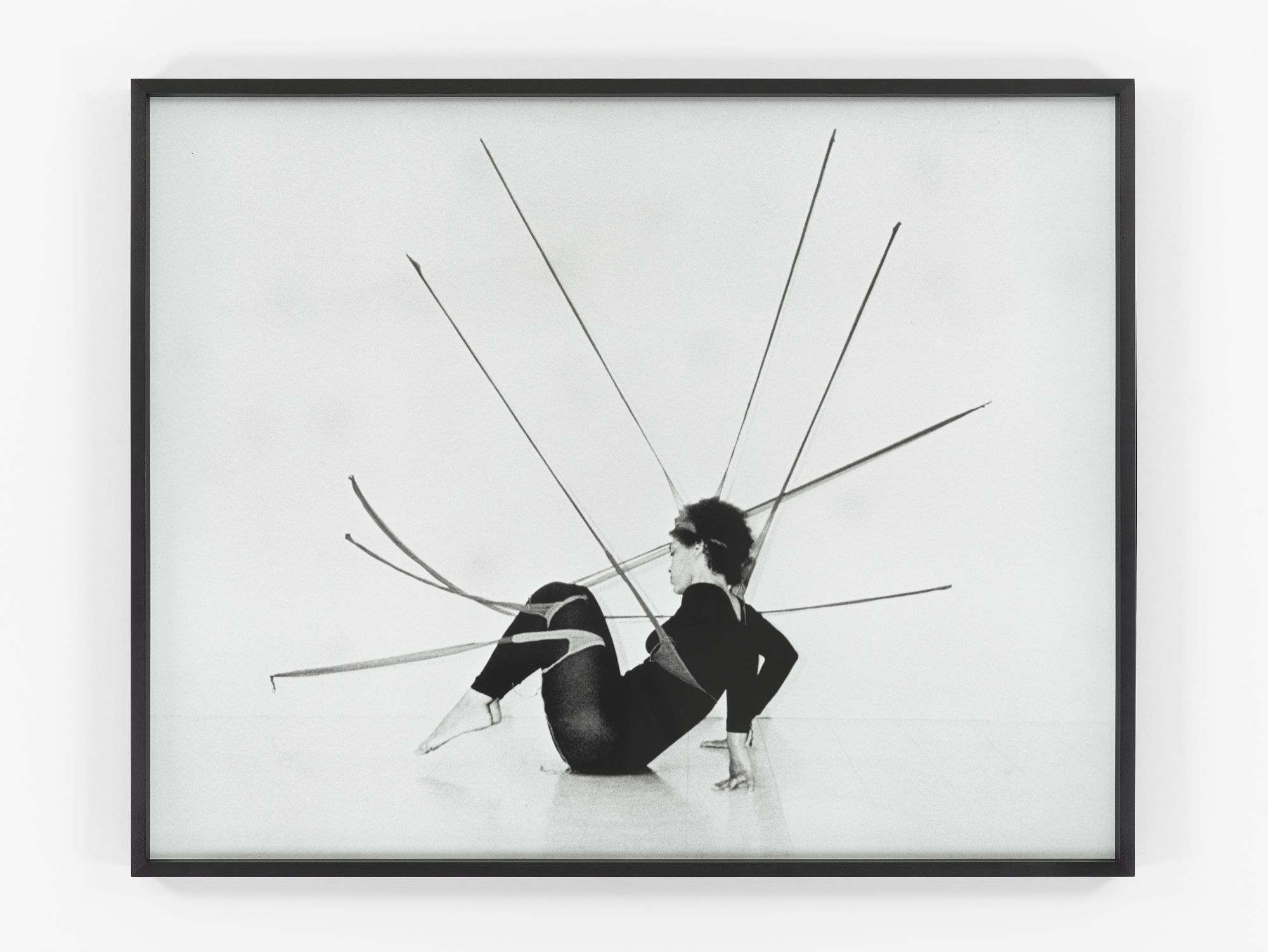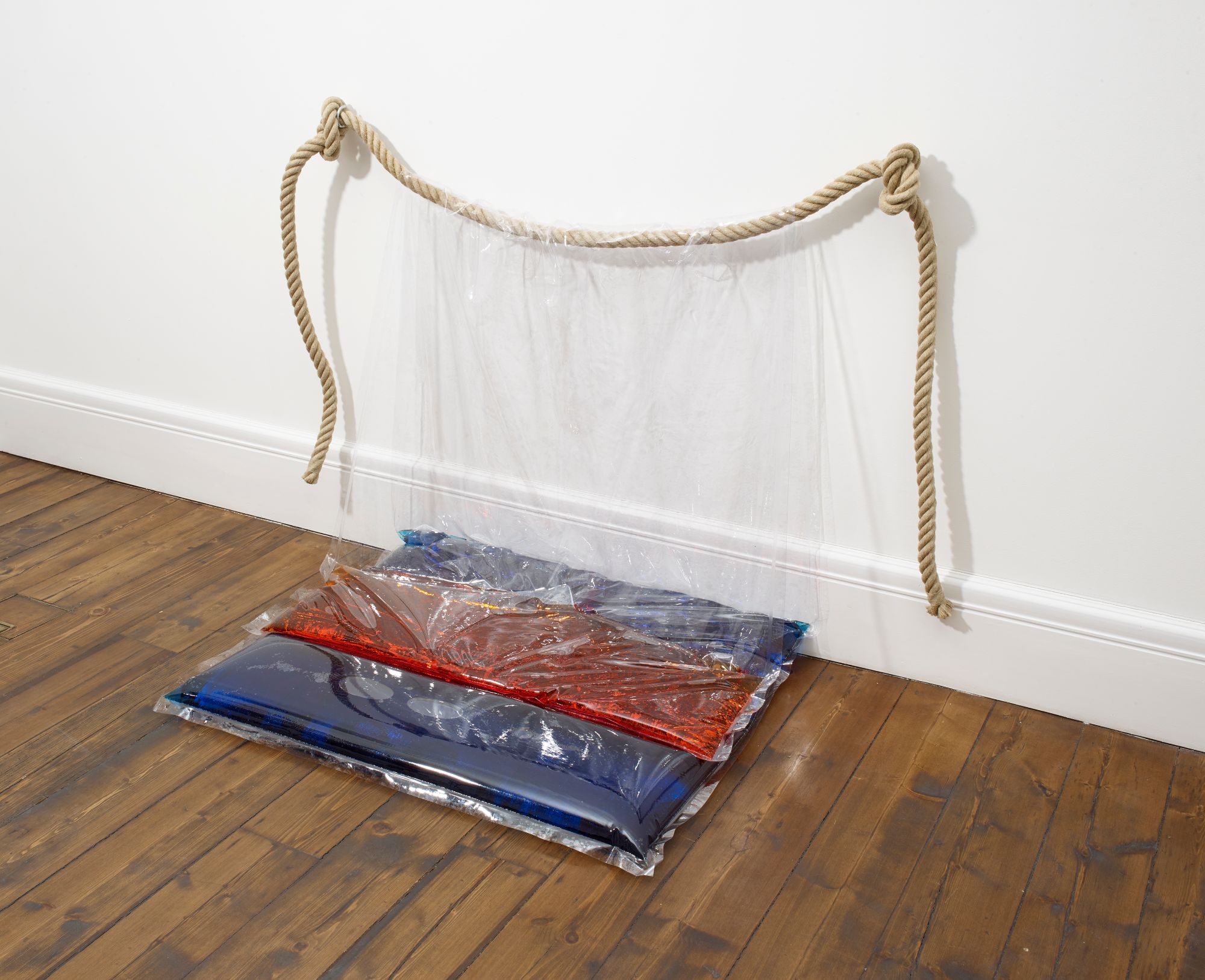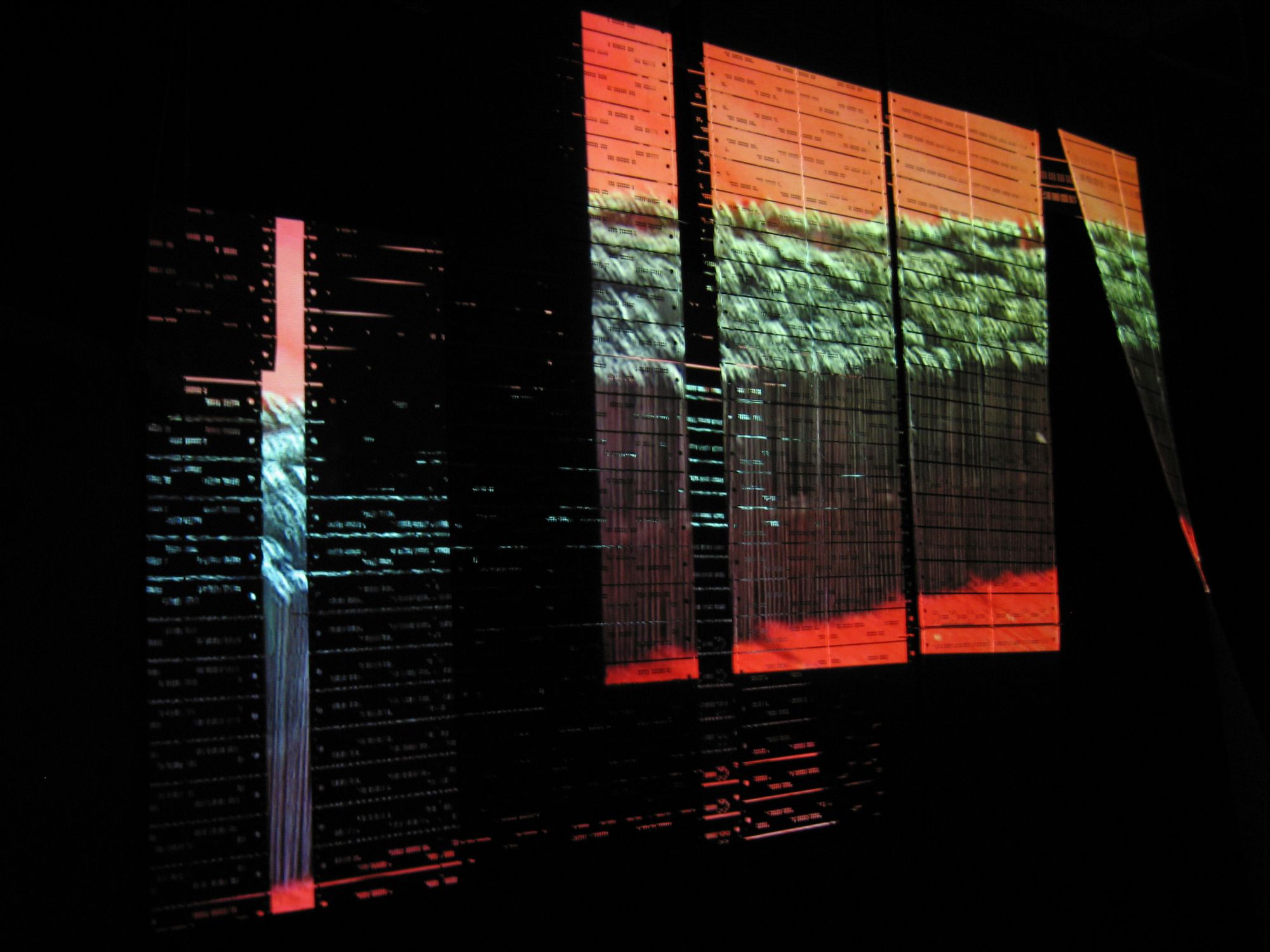センガ・ネングディ
Senga Nengudi

パフォーマンス・ピース
1978年
ゼラチン・シルバー・プリント
101.6×80 cm
作家蔵
撮影:Harmon Outlaw
Performance Piece
1978
Gelatin silver prints
101.6 x 80 cm
Collection of the artist
Photo:Harmon Outlaw
Courtesy: Sprüth Magers; Thomas Erben Gallery; Lévy Gorvy
パフォーマンス・ピース
1978年
ゼラチン・シルバー・プリント
101.6×80 cm
作家蔵
撮影:Harmon Outlaw
ネングディの彫刻作品「R.S.V.P.」シリーズを用いて行ったパフォーマンスの記録写真。新品ではないストッキングに砂が入れられた作品で、四方八方に引っ張られ、砂の重みで引き延ばされた状態は身体の伸縮性を表現しています。妊娠や年齢、または外部からの力や暴力などによって身体は変化し、それは私たちの「生のかたち」を表します。
作品において他者の反応や関与を重要だと考えるネングディは、作品をフランス語のフレーズ「Répondez s'il vous plaît」の略、「R.S.V.P.(お返事をください)」と名付けました。彼女は、「R.S.V.P.」を通じて多くの女性パフォーマーとコラボレーションをしています。壁に貼られたストッキングの網に捕らえられ、絡まり、拘束されるパフォーマーの身体は、人々に課された社会的制約や規範を暗示しているようです。
Performance Piece
1978
Gelatin silver prints
101.6 x 80 cm
Collection of the artist
Photo:Harmon Outlaw
Courtesy: Sprüth Magers; Thomas Erben Gallery; Lévy Gorvy
These photographs document a performance that was staged using Senga Nengudi’s “R.S.V.P.” series of sculptures. The sculptures are fashioned out of used stockings that have been tied together with sand in, pulled in all directions, and stretched by the weight of sand in a way that articulates the elasticity of the human body. Pregnancy, age, and external force and violence induce changes in the body, expressing the forms that our lives take.
Nengudi, who places great store by other people’s reactions to and involvement in her work, named her work “R.S.V.P.,” an abbreviation of the French phrase “répondez s’il vous plaît (please respond).” She has collaborated with many female performers through “R.S.V.P.” The bodies of the performers that are caught, entangled, and bound up in the web of stockings attached to the wall, seem to allude to the social restrictions and norms imposed on people.

ウォーター・コンポジション 3
1969-1970年/2018年
熱溶着したビニール、色水、ロープ
91.1×120×73 cm
Water Composition III
1969-1970/2018
Heat-sealed vinyl, colored water, and rope
91.1 x 120 x 73 cm
Courtesy: Sprüth Magers; Thomas Erben Gallery; Lévy Gorvy
ウォーター・コンポジション 3
1969-1970年/2018年
熱溶着したビニール、色水、ロープ
91.1×120×73 cm
「ウォーター・コンポジション」は、青やオレンジなどに着色された水を、熱で接着された透明なビニールの中に入れた立体のシリーズです。色水が入れられたビニールは、台座の上に置かれたり、太いロープで引っ張って固定されたりします。本作にはネングディが興味を抱いていた具体美術協会の元永定正(1922-2011年)の《作品(水)》(1956年)との関連性も見受けられます。
1960年代に発表された当初、鑑賞者はこの作品を触ることが許されていました。自重でぶら下がってごろりと横たわり、触れると力なく形を変えるその様子は、私たちの身体の性質に着想を得ています。本作は、身体の存在や重みをテーマにしたネングディのパフォーマンス作品への影響もみられます。
Water Composition III
1969-1970/2018
Heat-sealed vinyl, colored water, and rope
91.1 x 120 x 73 cm
Courtesy: Sprüth Magers; Thomas Erben Gallery; Lévy Gorvy
“Water Compositions” is a series of sculptures in which water that has been colored blue or orange is placed in clear, heat-sealed plastic bags. These bags, half filled with colored water, are placed on pedestals or pulled with a thick rope to hold them in place. There is an evident connection between this work and Work (Water) (1956) by Sadamasa Motonaga (1922-2011) of the Gutai Art Association, which Nengudi was interested in.
When this work was first exhibited in the 1960s, viewers were allowed to touch it. The way it hangs and lies down under its own weight, and changes its shape without effort when touched, is inspired by the nature of our own bodies. One can also perceive the influence of Nengudi’s performance work, which focuses on the sense of presence and weight of the body.

ワープ・トランス
2007年
マルチチャンネル・オーディオ、マルチチャンネル・ビデオ・インスタレーション
サイズ可変
作曲:Butch Morris
共同制作:ファブリック・ワークショップ・アンド・ミュージアム(フィラデルフィア)
Warp Trance
2007
Multi-channel audio and video installation
Dimensions variable
Sound composition: Butch Morris
In collaboration with: The Fabric Workshop and Museum, Philadelphia
Courtesy: Sprüth Magers; Thomas Erben Gallery; Lévy Gorvy
ワープ・トランス
2007年
マルチチャンネル・オーディオ、マルチチャンネル・ビデオ・インスタレーション
サイズ可変
作曲:Butch Morris
共同制作:ファブリック・ワークショップ・アンド・ミュージアム(フィラデルフィア)
本作は、ネングディにとって初めてのビデオ作品です。3つの映像がジャカード織機に使うパンチカードでできたスクリーンに投影されています。2007年にネングディがペンシルバニア州フィラデルフィアにあるファブリック・ワークショップ・アンド・ミュージアムで滞在制作していた際に制作されたものです。映像と音声は、地元の織物工場を訪れ収集されました。
織機の繰り返される動きと音に関心を持ったネングディは、作曲家のブッチ・モリス(1947-2013年)の協力を得て織物工場で録音し、その音を映像に合う楽曲に変換しました。最終的に、映像と音声は工場での様々なシーンが組み合わされたモンタージュとなりました。作品の音と映像の反復的なリズムはどこか儀式的でもあります。本作は、繰り返されるリズムと映像を通じて、テクノロジーの発展と労働、その儀式性など多岐にわたるテーマに触れています。
Warp Trance
2007
Multi-channel audio and video installation
Dimensions variable
Sound composition: Butch Morris
In collaboration with: The Fabric Workshop and Museum, Philadelphia
Courtesy: Sprüth Magers; Thomas Erben Gallery; Lévy Gorvy
Collection of the artist
This work is Nengudi’s first video work, consisting of three images projected onto a screen made of the punched cards used in Jacquard looms. The work was created during Nengudi’s residency at the Fabric Workshop and Museum in Philadelphia, Pennsylvania in 2007. The images and sounds were collected during a visit to a local textile factory.
Intrigued by the repetitive movements and sounds of the looms, Nengudi enlisted the help of composer Butch Morris (1947-2013) to record the sounds at the textile mill and transform them into a musical composition to accompany the images. In the end, the video and audio became a montage of various scenes from the factory.
The repetitive movements and rhythms of sound and image in the work have a certain ritualistic quality to them. Through these repeated rhythms and images, the work addresses a wide range of themes, including technological development, labor and its ritualistic nature.
アーティスト一覧ARTISTS
- Etel Adnan|エテル・アドナン
- Phyllida Barlow|フィリダ・バーロウ
- Anna Boghiguian|アンナ・ボギギアン
- Miriam Cahn|ミリアム・カーン
- Lili Dujourie|リリ・デュジュリー
- Anna Bella Geiger|アンナ・ベラ・ガイゲル
- Beatriz González|ベアトリス・ゴンザレス
- Carmen Herrera|カルメン・ヘレラ
- Kim Soun-Gui|キム・スンギ
- Suzanne Lacy|スザンヌ・レイシー
- Mishima Kimiyo|三島喜美代
- Miyamoto Kazuko|宮本和子
- Senga Nengudi|センガ・ネングディ
- Nunung WS|ヌヌンWS
- Arpita Singh|アルピタ・シン
- Robin White|ロビン・ホワイト

